撰文:Lydia Wu
TL; DR
-
狭义上的预测市场通常不包含传统博彩和体育博彩,更强调信息发现和公共决策参考功能;
-
预测市场不能保持「正确」,失败的案例正是由于人们将预测市场给出的概率视为已然的事实;
-
加密货币为预测市场带来了更加自由的交易金额和更小摩擦的支付体验;
-
Polymarket 的用户画像和 NFT 交易者、Meme 玩家等加密原生用户存在较大的区别,他们通常更年长、不追求极致盈亏比,且有强烈的信息获取和分析动机;
-
预测市场产品的竞争要素体现在如何编排更优质的事件,以及聚集理智的下注者 ( 创作者 )。Polymarket 的竞争优势在于出圈带来的注意力 ( 流动性 ) 基数;
-
Polymarket 对交易量激励和更复杂的交易功能非常谨慎。那些从衍生品交易的角度去切入预测市场的新项目,可能会面临功能错配带来的水土不服;
-
11 月 5 日大选结束之后,Polymarket 预计会面临大量的流动性撤退,届时大众对其选举成绩单的评价、以及 Polymarket 下一步的战略规划,很有可能会对未来的预测市场产生深远的影响;
崛起:「那个预测市场」
Polymarket 是目前最大的「2024 年美国大选预测市场」,用户在哈里斯和特朗普的谁将当选的问题上累计押注了近 15 亿美元,这一数字将其在 Web2 的竞争对手 PredictIt, Smarkets 等远远甩在身后——后两者在相同问题上的交易规模分别为 3700 万美元和 900 万美元。
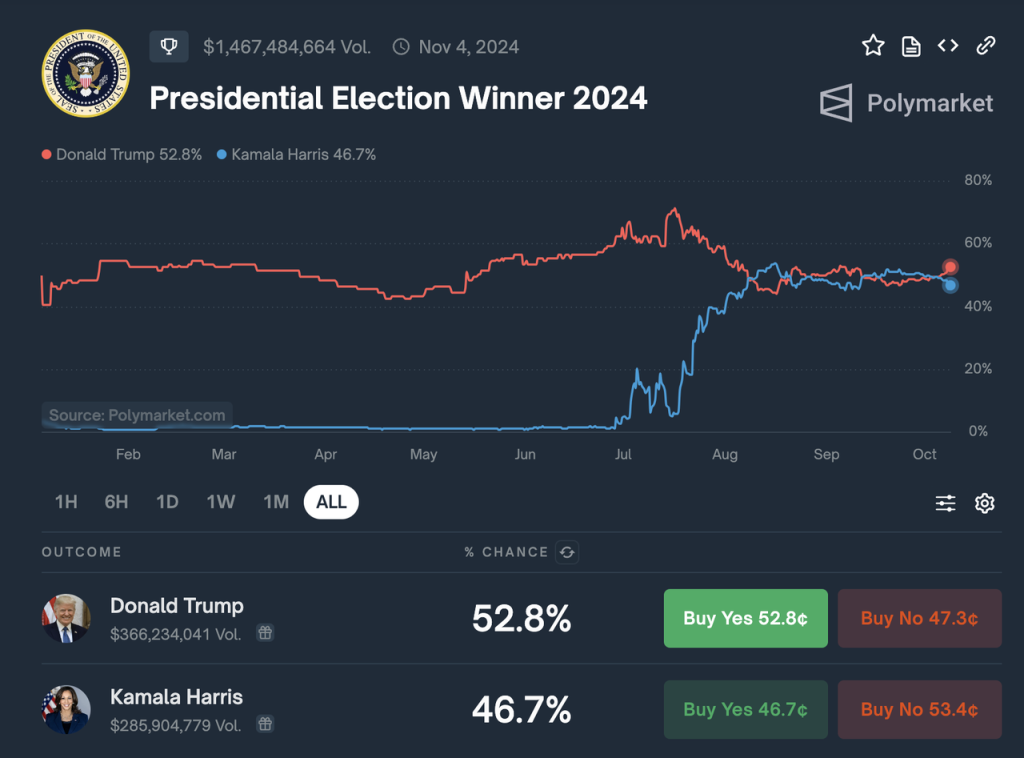
Polymarket 2024 年美国大选界面
预测市场的概念辨析
广义上的预测市场由博彩和投注市场演变而来,指人们将资金投入某个事件结果的预期上并希望获得回报。
狭义上的预测市场通常不包含传统博彩和体育博彩,而是指向更广泛的政治、经济、文化事件,强调信息发现功能,可能为政策制定或公共决策提供参考。这种性质的预测市场至少可以追溯到 16 世纪初的罗马教皇选举,1988 年美国总统大选期间推出的爱荷华电子市场 (Iowa Electronic Markets) 是最早的现代电子预测市场之一。
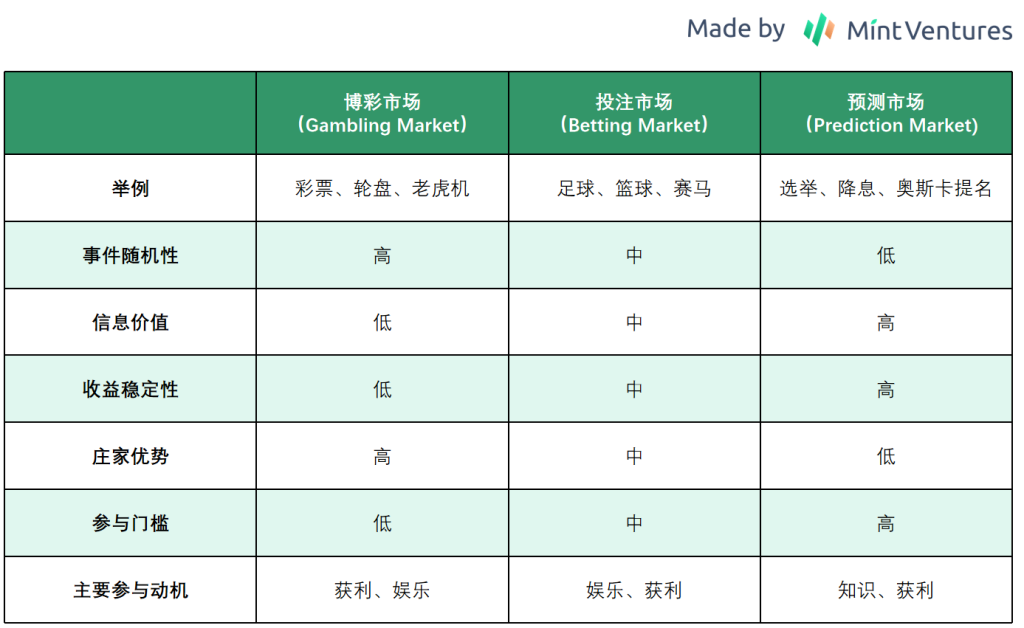
加密预测市场 = 真相机器 ?
Vitalik Buterin 可能是 Web3 世界最有影响力的预测市场倡导者。早在 2014 年,他便将预测市场当作 Futarchy (Robin Hanson 设想的一种以投注治国的未来政府形式 ) 的一种实践进行了讨论;在 2020 年的一篇探索「可信中立」机制的文章中,他再次将预测市场作为案例,随后还提出了一种将极不可能事件绑定下注的预测市场设计;2021 年,他发文系统论述了预测市场的价值支撑以及去中心化的优势;本周期以来,他更是频繁公开表示对预测市场的看好,并参投了 Polymarket 在今年 5 月的 B 轮融资。
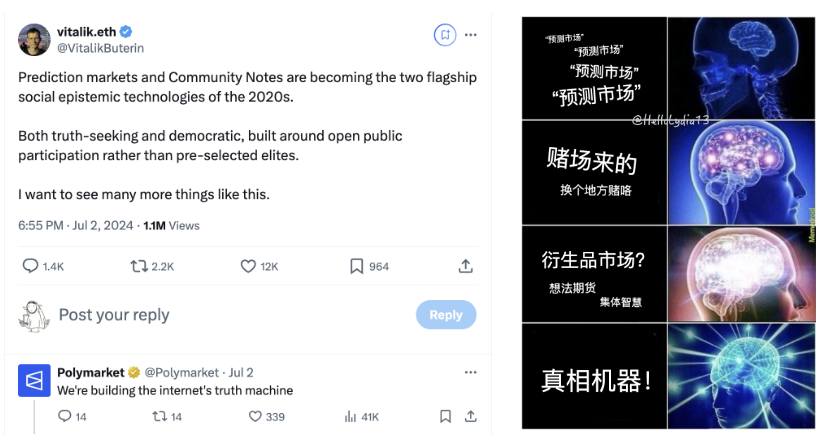
不同大脑对预测市场的理解
要理解预测市场背后的理念以及加密人士对其寄予的野望,我们可以从三个小问题出发:
-
预测结果代表了什么?
-
预测市场到底准不准?
-
加密货币为预测市场带来了什么?
出于篇幅限制,我将对这三个问题做出简要的回答。
预测市场的预测结果代表了什么?是真相吗?
真相 (Truth) 机器的说法是有争议的。预测市场测量的是人们对符号化的事件 (Event) 的理解,并以此作为推测未来客观事实 (Fact) 的依据,这一过程并不生产真相,只是参与者对事件结果的概率估计。即便预测结果与事实相符,也是一种事后验证。
预测市场到底准不准呢?
预测市场的合法性基因分析一般可以追溯到哈耶克、贝叶斯定理、Futarchy、有效市场假说等等,这里尝试将他们糅合到一起用一句话阐述便是:虽然知识在人类社会中是分散的,但若是有足够多的市场参与者,通过观察新出现的证据不断更新观点,便可以形成一个资产价格反应所有公开信息的有效市场,从而对决策实施提供帮助。
预测市场的支持者经常援引的案例包括 2008 年美国大选和 2020 年 Polymarket 在新冠疫情中的表现,但预测市场在 2016 年英国脱欧和美国大选中不尽如人意的表现又削弱了这一论点。预测市场「失灵」的情况,根据人们的事后反思,在于交易员们将预测市场给出的概率视为已然的事实,放弃了对外部信息的及时更新,从而导致价格过于稳定。这也暗示了预测市场的反身性——人们的信任正在损伤可信的根基。
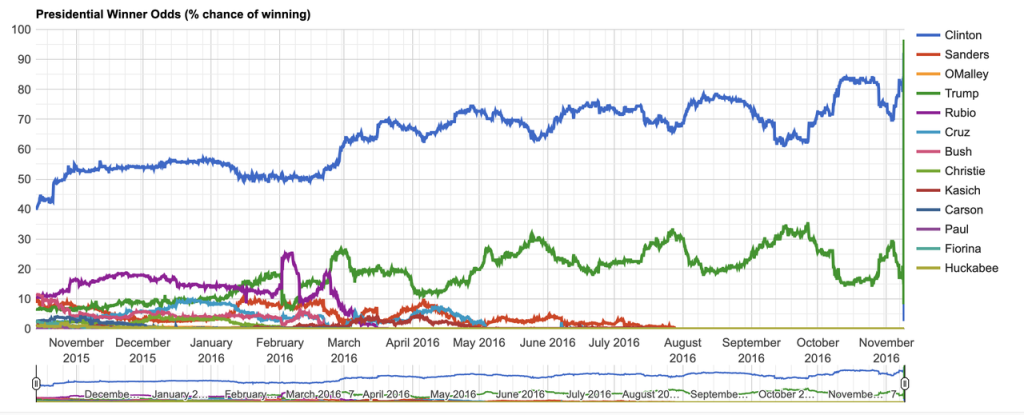
2016 年大选的投注赔率,希拉里始终保持绝对领先
在预测市场悠久的历史中,加密货币扮演了什么样的角色?
从预测市场的概念实践来说,去中心化的预测市场通常没有下注金额的限制 ( 与之相比,PredictIt 的下注限额是 850 美元 ),能够让人们根据信心程度更加自由地对观点赋予金钱权重,有可能能更精准地捕捉市场趋势。
从预测市场的运营角度来说,使用加密货币不仅能够更加即时收款,还能极大降低客户在事后通过信用卡公司要求退款 ( 即拒付欺诈 ) 的比例,知名在线博彩平台 Stake 便只接受加密货币支付。
Polymarket 的崛起
一个广泛的疑问是:既然预测市场的概念和实践由来已久,与加密货币的结合也并不新鲜,为何偏偏是 Polymarket 异军突起,以链上之躯在现有市场中竞争并获得最大的市场份额,以至于几乎成了「预测市场」的代名词?
首先值得一提的是,2024 年是一个难得的全球选举大年。据不完全统计,2024 年全球有 76 个国家 / 地区举行大选,覆盖 41.7 亿人口。其中美国大选无疑获得了最多的关注,拜登的退选、特朗普遇刺也增加了过程的一波三折。
此外,巴黎夏季奥运会的开幕、美联储的降息决议、地缘政治的危机、人工智能的进展等全球性事件得到了广泛的报道和关注。在 Web3 世界,比特币减半、比特币和以太坊的 ETF 等也创造了足够的话题度——这对于预测市场来说无疑是一个「黄金年代」。
而 Polymarket 自身的成功,常被归为相较于前几代产品更丝滑的 UXUI,更顺畅的出入金体验,以及相较于 Web2 竞品更透明的机制和不抽水的设计。碰上时势的顺风,一时间风头无两。

2024 年 Polymarket 上创建的事件数量增幅明显

新用户的涌入迅速推高了 Polymarket 的用户基数

Polymarket 的交易量在 2024 年明显放大
时局的变化、行业的积累、以及 Polymarket 本身的产品迭代固然重要,但本文想关注一个目前甚少被提及的角度——Polymarket 的市场策略,以及我们对 Polymarket 可能存在的误解。
误解:「事件交易平台」
开宗明义,相较于乌托邦式的「预测市场」,或者管中窥豹式的「事件交易平台」,一个对目前的 Polymarket 更明确和去泡沫化的描述可能是「加密媒体 / 创作者生态 / 信息平台」。
暗处的读报人群
Polymarket 在 9 月创下了 9 万的月活新高,日活基本保持在 1 万以上。然而 Polymarket 网站的访问量在 9 月达到了 1500 万,访问量 / 月活比值超过了 166。
与之相比,Opensea 在 9 月月活为 11 万,日活在 9 千左右,与 Polymarket 接近。Opensea 在 9 月的网站访问量为 450 万,访问量 / 月活比值约为 41。
如果加入 pump.fun,进一步对比这三个各自赛道内的明星产品,可以发现 Polymarket 的访问量,以及来自移动端的比例要明显高于其他两者——反映了 Polymarket 背后大概率有一个与 NFT 交易者和 Meme 玩家不同的「读报人群」。

Polymarket 的月活和日活数据

Opensea 的月活和日活数据

Polymarket, Opensea, pump.fun 的网站数据对比
来源: similarweb
事实上,Polymarket 的创始人 Coplan 在 X 上一直使用包括「替代新闻源」 (Alternative news source), 「未来媒体」 (The future of media) 等词汇描述自己的产品,并且多次引用 Polymarket 在 App Store 新闻板块下的排名。数据显示,Polymarket 虽然网站访问量只有纽约时报的 3%,但在页面停留时长、跳出率等指标上的表现都较为优秀。
此外,Polymarket 通过与 Substack, Bloomberg 等媒体和信息平台的整合也扮演了一个「反向预言机」的角色,代表 Web3 世界传递更多样的意见和情绪。
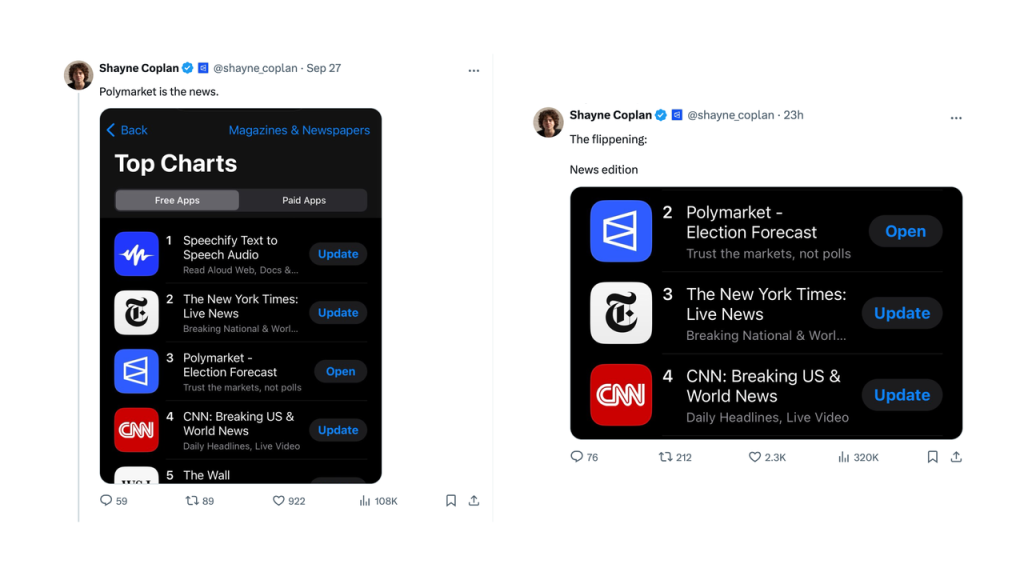
Coplan 认为 Polymarket is the news

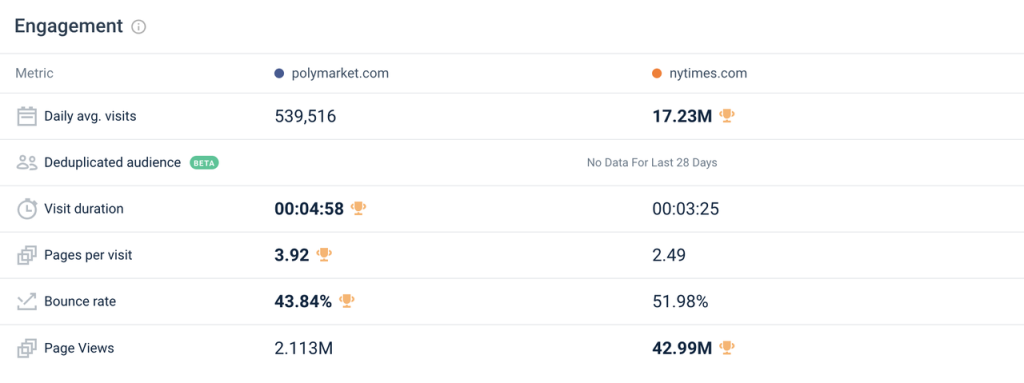
Polymarket 和纽约时报的网站数据对比
来源: similarweb
特殊的交易者
Polymarket 不需要一个庞大的采编团队,核心内容生产交由真金白银下注的交易者完成,这群人是 Polymarket 的智力资产。预测市场的概念起源和曾经的失败经历无不在强调市场参与者的重要性,他们的理性分析和对新信息的不断再评估是预测市场能够「准确」的基石。
一篇发表于 2022 年、面向超过 4 万芬兰居民在线赛马投注行为的研究显示,拥有更高数值 IQ ( 即在算数推理、数学问题解决和定量分析测量中表现更好 ) 的人会对基于技能的赌博 ( 与之相对的是基于运气的赌博 ) 呈现出明显更高的参与意愿。该研究还显示,在总下注人群中,约 9% 的玩家收益大于损失。在 Polymarket 中,这一比例为 11.5%。
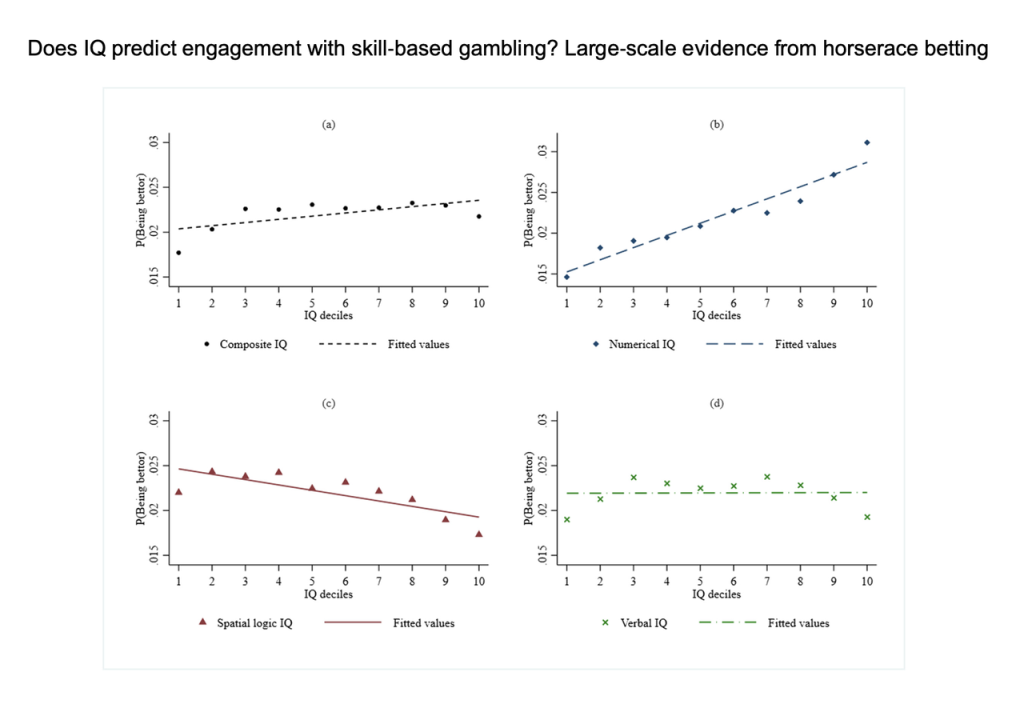
(a): 综合 IQ 与参与赛马投注意愿整体呈现正相关
(b): 数值 IQ 与参与赛马投注意愿呈现明显的正相关
(c): 空间逻辑 IQ 与参与赛马投注意愿呈现明显的负相关
(d): 语言 IQ 与参与赛马投注意愿不相关

Polymarket 玩家 P&L 情况
Polymarket 的广告链接来源也透露了一些「吸引和转化什么样的人」方面的策略。
-
排名第一的 electionbettingodds.com 是一个知名的选举预测市场聚合器,聚合了包括 Polymarket 在内的 5 个预测市场的数据
-
citizenfreepress.com 是一个偏向保守派的美国政治新闻聚合网站,其中一半用户是超过 55 岁的美国男性
-
natesilver.net 是统计学家、作家和扑克玩家 Nate Silver 的 Substack。Nate 开发的选举预测系统曾成功预测了 2008 年美国总统选举 50 个州中 49 个州的结果,他在今年 6 月以顾问的身份加入了 Polymarket
-
前 10 位只有 coindesk 和 dappradar 是主要面向加密原生用户的应用
-
和 Opensea 以及 pump.fun 对比,Polymarket 的用户年龄分布更加均衡,35 岁以上的人群占比明显高于其他两者

Polymarket 广告链接来源排名前 10 的网站
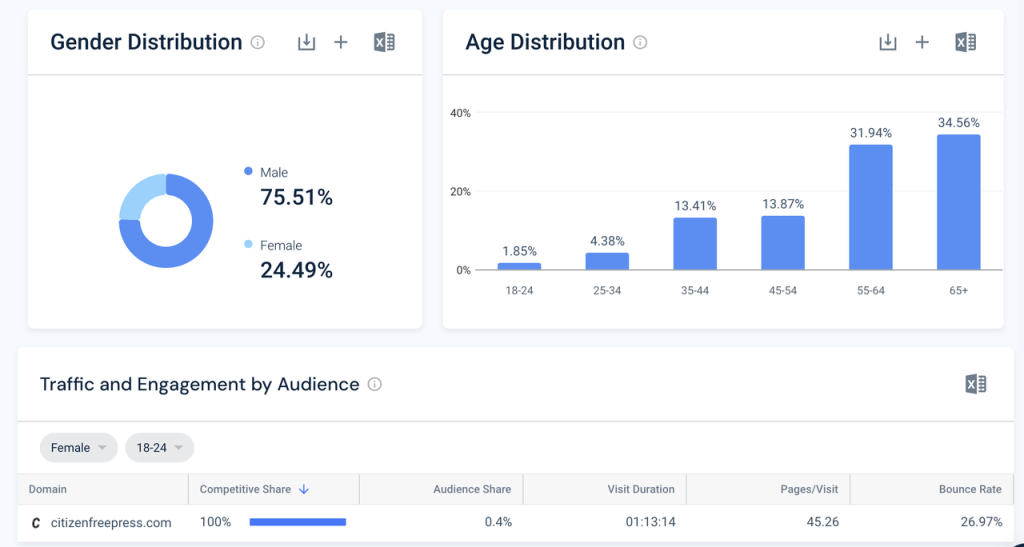
citizenfreepress.com 的用户性别和年龄分布

Polymarket, Opensea, pump.fun 的用户年龄构成
来源: similarweb
我们几乎没有听到过 Polymarket 上的「传奇交易员」的故事。这是预测市场的特性决定的——控制赔率在合理范围内,避免结果大幅偏离事件的实际可能性。
Polymarket 的排行榜数据佐证了这一点。目前总盈利超过 100 万美元的用户仅有 3 位,而 pump.fun 上总盈利超过 100 万美元的地址有 197 个。考虑到 Polymarket 的 9 月月活为 pump.fun 的 14%,且成立于 2020 年,靠 Polymarket 致富的概率似乎更小。
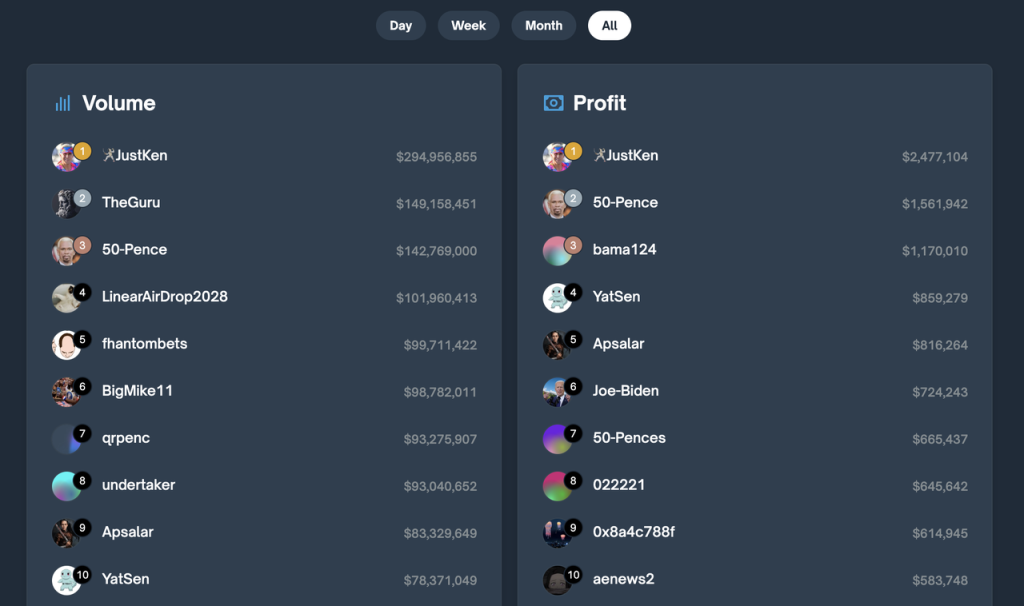
Polymarket 排行榜
相应的,Polymarket 的交易功能也做得较为克制。除了出入金外,只有最基础的市价和限价单功能。虽然在今年 6 月开源了可以抵押资产借出 USDC 的借贷协议 Polylend,但 Polymarket 明确表示此功能不会用于生产,只是方便社区构建。此外,Polymarket 也没有进行大规模的流动性激励。Polymarket 似乎认为过于复杂的交易功能会模糊用户的下注意图,而做市和流动性激励会扭曲市场的有效性。
虽然从「读报」到「交易」的实际转化情况难以估计,但我们还是可以粗略描绘出理想情况下、聚集在 Polymarket 上的人群画像——这是一个相对理性和成熟的群体,可能原先对加密货币了解不多,通常在经济上更加稳定,不追求极致的盈亏比,更享受通过分析判断证明自己正确的乐趣。这样的形象与普遍意义上的加密赌徒相去甚远,也是目前的 Web3 产品很难触达的。
失速:关键的 11 月
在航空术语中,「失速」指的是飞机机翼相对气流的角度过大,不足以产生足够的升力,从而导致高度快速下降。面对失速的飞机,飞行员需要将机头下压、增加推力来使得飞机恢复升力。
Polymarket 的崛起速度和选举「大单品」策略引发了市场对其后续推力的担心——在 11 月 5 日美国大选一锤定音之后,Polymarket 将何去何从?毕竟 Polymarket 从不缺虎视眈眈的竞争对手、野心勃勃的新进场玩家,以及持续发声的质疑者。

Polymarket 上选举相关的交易量达到了 70%,用户量达到了 60%
Polymarket 的先后手
对 Polymarket 来说,本次大选的成绩单至关重要,其结果关乎预测市场本身的公信力,以及 Polymarket 能否隔离团队和投资人的政治倾向,真正地「代表民意」。
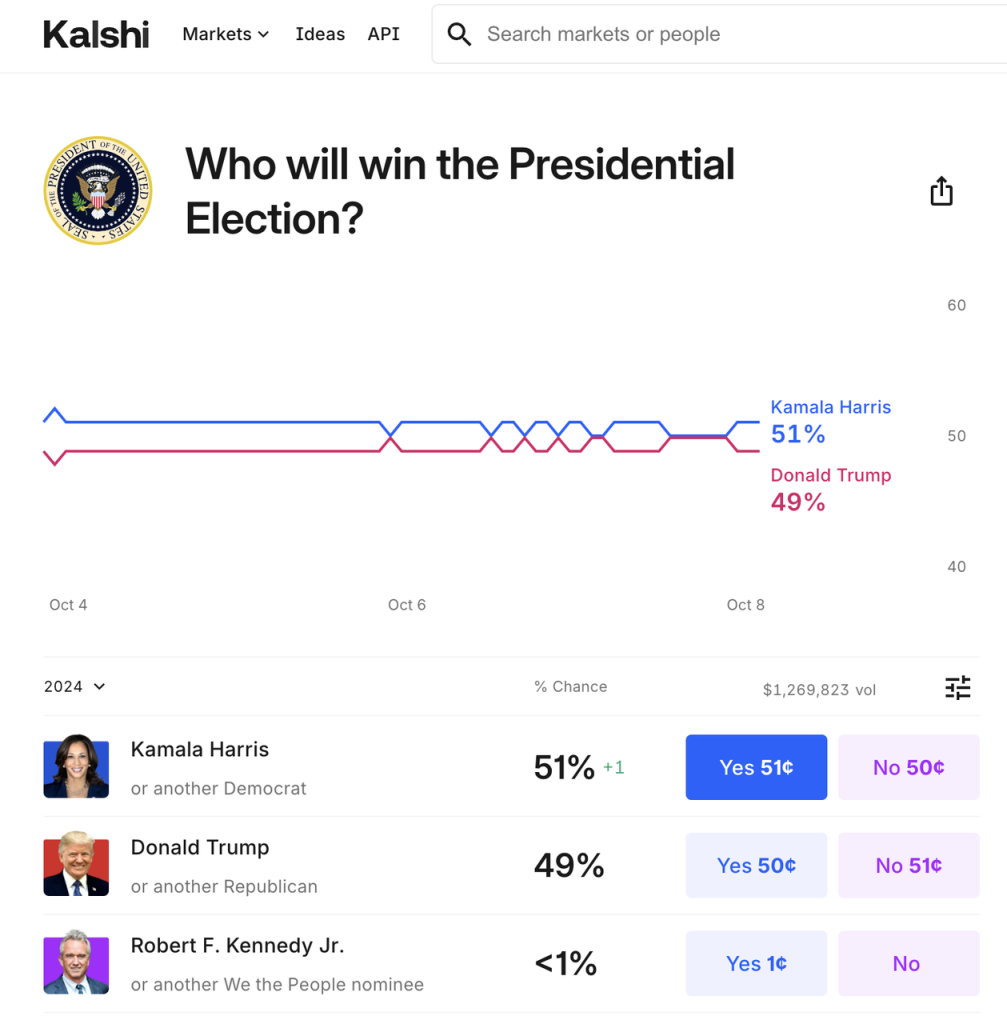
与特朗普在 Polymarket 上最新的反超不同,另一家预测市场 Kalshi 始终显示哈里斯领先

领投Polymarket 的 Funders Fund 创始人 Peter Thiel「非常强烈地支持特朗普」
大选结束后,面对下滑的交易量和流失的用户,目前讨论到的 Polymarket 的应对策略 ( 也是新进场玩家觊觎的方向 ),大致可以分为三类:
1.发展体育博彩
体育是目前 Polymarket 上仅次于选举的第二大事件品类,但交易量仍有数量级的差距,可能主要受益于选举话题的流量溢出。这部分流量能否在选举结束后长期留存是存疑的。

体育题材的超级碗和英超跻身 Polymarket 交易量前 8
且不谈体育博彩是一个极为分散和饱和的市场,体育博彩本非预测市场的核心领域,球迷下注的因素常常是感性驱动,享受即时刺激,增强观赛体验,并不追求长远盈利,这与预测市场的筛选逻辑存在相悖之处。
2.增加衍生品交易
同样是一个饱和的市场,对 Polymarket 来说无疑是扬短避长。
3.做成「事件的 pump.fun」
这是一个流行的思路,讲述了一个人人都可发行事件、进行预测的开放市场,似乎针对了 Polymarket 的用户无法自主创建市场,需要团队集中「上事」的特点。但如果我们推敲一下最受欢迎的选举事件的特点,就会发现选举本身:
-
影响非常广泛→流动性充足
-
周期较长、穿插多个过程事件→信息尽可能充分流通
-
确定时间、二元结果→明确的结算
类似的,Polymarket 公布的「上事」考虑因素包括:
-
是否有足够的交易需求以产生准确的概率
-
事件的概率结果是否有社会价值或者新闻价值
-
事件是否能在确定时间范围内得到明确的结果
对于大多数人来说,想出一个界定清晰的二元问题,然后用准确无歧义、同时不能过于专业的语言表述出来,再设定一个明确的结算点和标准,结果还要有一定的社会意义…这样做的难度要比上传一张图片发 Meme 要高得多。
即便是 Polymarket ,也曾因「ETF 通过」「特朗普儿子参与」等问题的标准不明而引发争议。如果做一个完全开放的市场,作恶风险 ( 比如特朗普发一个自己下一次演讲会不会说某个词的事件 ),以及争议裁决 ( 比如如何界定特朗普有没有参与 ) 将会给平台带来巨大的负担。
至此我们发现,这三种看似与 Polymarket 相关的转型方向都绝非易事,核心还是在于 Polymarket 很难强化、也不应该强化交易和投机的属性。即便是传出发币意图,Polymarket 对激励的使用也应处处小心,比如更多地激励优质提问和正确结果,而非交易量。
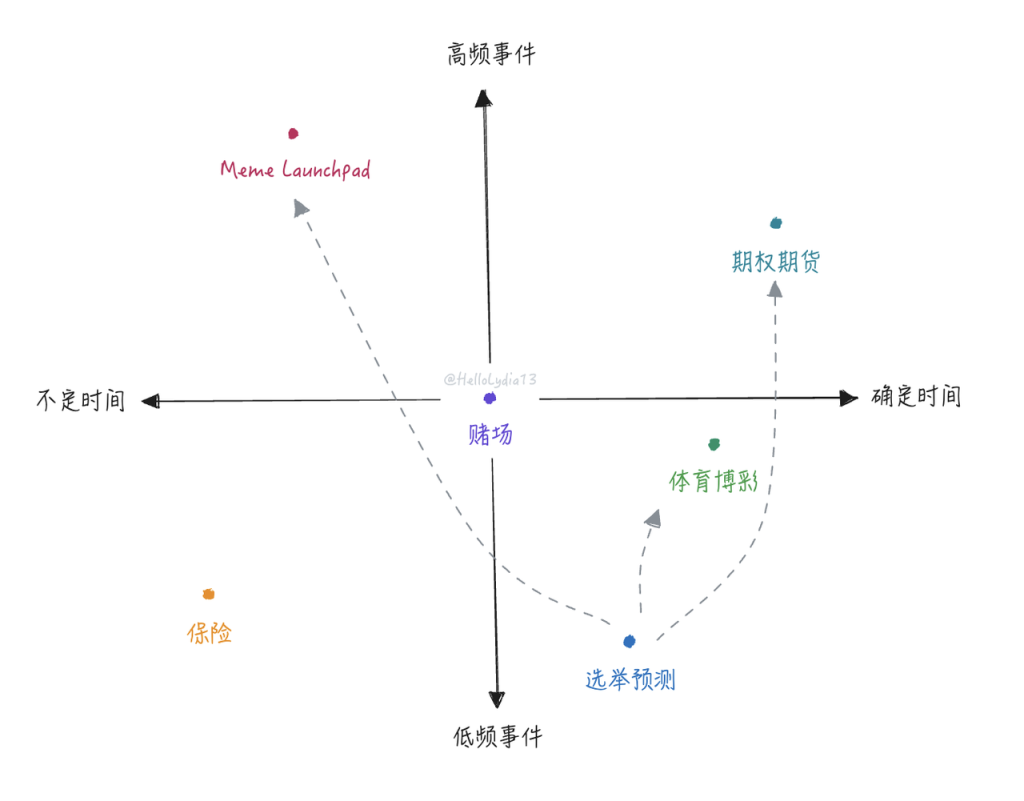
选举预测的「转型思路」与现有业务之间存在事件特性和时间周期上的差异
房间里的监管
在监管形势进一步明朗前,Polymarket 的 token 可能不会来得那么快。
和博彩沾边的市场一直受到非常严苛的监管,Polymarket 曾在 2022 年被 CFTC 勒令支付 140 万美元的罚款并停止在美国的业务。今年 5 月,CFTC(美国商品期货交易委员会)发布了一项拟议规则,旨在禁止所有与美国选举相关的衍生品交易。同样在 5 月公布的 7000 万美元融资中, Polymarket 表示其使命是作为公共产品向公众提供更准确、实时的事件预测。
好消息在大选前的最后几周传来。继上个月哥伦比亚地方法院选择支持选举预测市场后,一家联邦上诉法院也拒绝了 CFTC 阻止选举投注的要求。此前 CFTC 发出的警告称「此类合同的使用方式可能会对选举的公正性或对选举公正性的看法产生不利影响」。
市场的眼光再次回到 Polymarket 即将交出的成绩单上。
免责声明:本文章仅代表作者个人观点,不代表本平台的立场和观点。本文章仅供信息分享,不构成对任何人的任何投资建议。用户与作者之间的任何争议,与本平台无关。如网页中刊载的文章或图片涉及侵权,请提供相关的权利证明和身份证明发送邮件到support@aicoin.com,本平台相关工作人员将会进行核查。




